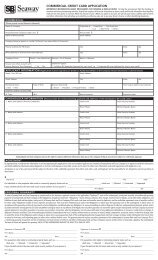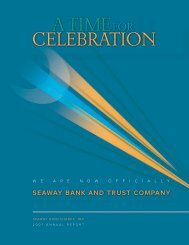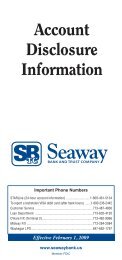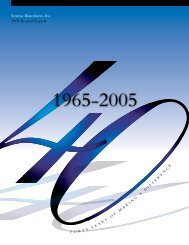Same commitment. - Seaway Bank and Trust Company
Same commitment. - Seaway Bank and Trust Company
Same commitment. - Seaway Bank and Trust Company
You also want an ePaper? Increase the reach of your titles
YUMPU automatically turns print PDFs into web optimized ePapers that Google loves.
Note 2, continued<br />
December 31, 2007: consolidated B bank Only<br />
estimated Fair Value Approximate Carrying Value estimated Fair Value Approximate Carrying Value<br />
Financial Assets:<br />
Cash <strong>and</strong> Short-term Investments $ 18,463,000 $ 18,463,000 $ 18,462,000 $ 18,462,000<br />
Investment Securities 131,951,000 131,951,000 131,951,000 131,951,000<br />
Loans 177,571,000 181,246,000 177,571,000 181,246,000<br />
Unallocated Reserves for loan losses — (1,840,000) — (1,840,000)<br />
Loan, Net 177,571,000 179,406,000 177,571,000 179,406,000<br />
Total Financial Assets $ 327,985,000 $ 329,820,000 $ 327,984,000 $ 329,819,000<br />
Financial Liabilities<br />
Deposits 300,148,000 300,148,000 301,034,000 301,034,000<br />
Short-Term Borrowings 1,125,000 1,125,000 1,125,000 1,125,000<br />
Long-Term Debt 10,660,000 11,186,000 5,597,000 5,000,000<br />
Total Financial Liabilities 311,933,000 312,459,000 307,756,000 307,159,000<br />
Core Deposit Intangibles 12,631,000 — 12,691,000 —<br />
Fixed Assets <strong>and</strong> Net Other Assets <strong>and</strong> Liabilities 11,747,000 11,747,000 12,528,000 12,528,000<br />
Net Total Asset Value $ 40,430,000 $ 29,108,000 $ 45,447,000 $ 35,188,000<br />
Note 3 — Fair Value Measurements<br />
Effective January 1, 2008 the Corporation adopted the provisions of SFAS No.<br />
157, “Fair Value Measurements” for assets <strong>and</strong> liabilities measured <strong>and</strong> reported at<br />
fair value. SFAS 157 defined fair value, establishes a framework for measuring fair<br />
value <strong>and</strong> exp<strong>and</strong>s disclosures about fair value measurements.<br />
SFAS 157 defines fair value as the price that would be received to sell an asset<br />
or paid to transfer a liability in an orderly transaction between market participants.<br />
SFAS 157 requires the use of valuation techniques that are consistent with<br />
the market approach, the income approach <strong>and</strong>/or the cost approach. Inputs to<br />
valuation techniques refer to the assumptions that market participants would<br />
use in pricing the asset or liability. Inputs may be observable, meaning those that<br />
reflect the assumptions market participants would use in pricing the asset or<br />
liability developed based on market data obtained from independent sources, or<br />
unobservable, meaning those that reflect the reporting entity’s own assumptions<br />
about the assumptions market participants would use in pricing the asset or liability<br />
developed based on the best information available in the circumstances. In<br />
that regard, SFAS 157 established a fair value hierarchy for valuation inputs that<br />
gives the highest priority to quoted prices in active markets for identical assets or<br />
liabilities <strong>and</strong> the lowest priority to unobservable inputs. The fair value hierarchy<br />
is as follows:<br />
Level 1: Quoted prices (unadjusted) for identical assets or liabilities in active<br />
markets that the entity has the ability to access as of the measurement date.<br />
Level 2: Significant other observable inputs other than Level 1 prices such as<br />
quoted prices for similar assets or liabilities; quoted prices in markets that are not<br />
active; or other inputs that are observable or can be corroborated by observable<br />
market data.<br />
Level 3: Significant unobservable inputs that reflect a reporting entity’s own<br />
assumptions about the assumptions that market participants would use in pricing<br />
an asset or liability.<br />
A description of the valuation methodologies used for assets <strong>and</strong> liabilities<br />
measure at fair value, as well as the general classification of such instruments<br />
pursuant to the valuation hierarchy, is set forth below.<br />
Securities Available for Sale<br />
When available, quoted market prices are used to determine the fair value of<br />
investment securities <strong>and</strong> such items are classified within Level 1 of the fair value<br />
hierarchy. An example is U.S. Treasury securities. For other securities, the Corporation<br />
determines fair value based on various sources <strong>and</strong> may apply matrix pricing<br />
with observable prices for similar bonds where a price for the identical bond<br />
is not observable. Securities measured at fair value by such methods are classified<br />
as Level 2. Certain securities are not valued based on observable transactions <strong>and</strong><br />
are, therefore, classified as Level 3. The fair value of these securities is based on<br />
management’s best estimates.<br />
Impaired Loans<br />
Impaired loans are evaluated <strong>and</strong> valued at the time the loan is identified as<br />
impaired, at the lower cost of fair value. Fair value is measured based on the value<br />
of the collateral securing these loans <strong>and</strong> is classified at a level 3 in the fair value<br />
hierarchy. Collateral may be real estate <strong>and</strong>/or business assets including equipment,<br />
inventory <strong>and</strong>/or accounts receivable <strong>and</strong> is determined based on appraisals<br />
by qualified licensed appraisers hired by the Corporation. Appraised <strong>and</strong> reported<br />
values may be discounted based on management’s historical knowledge, changes<br />
in market conditions from the time of valuation, <strong>and</strong>/or management’s expertise<br />
<strong>and</strong> knowledge of the client <strong>and</strong> client’s business.<br />
Loans Held for Sale<br />
Loans held for sale are carried at the lower of cost or market value. The fair value<br />
of loans held for sale is based on what secondary markets are currently offering<br />
for portfolios with similar characteristics. As such, the Corporation classifies loans<br />
subjected to nonrecurring fair value adjustments as Level 2.<br />
Assets <strong>and</strong> Liabilities Recorded at Fair Value on a Recurring Basis<br />
The following table summarizes assets <strong>and</strong> liabilities measured at fair value on a recurring basis as of December 31, 2008, segregated by the level of the valuation inputs<br />
within the fair value hierarchy utilized to measure fair value.<br />
Fair Value Measurements at December 31, 2008 Using:<br />
December 31, 2008 Quoted Prices in Active Significant Other Significant<br />
markets for Identical Observable Inputs unobservable Inputs<br />
Assets (Level 1) (Level 2) (Level 3)<br />
Securities available for sale 137,928,610 1,147,508 136,781,102 —<br />
Assets <strong>and</strong> Liabilities Recorded at Fair Value on a Nonrecurring Basis<br />
The Corporation may be required, from time to time, to measure certain assets <strong>and</strong> liabilities at fair value on a nonrecurring basis in accordance with U.S. generally accepted<br />
accounting principles. These include assets that are measured at the lower of cost or market that were recognized at fair value below cost at the end of the period.<br />
Assets measured at fair value on a nonrecurring basis are included in the table below.<br />
Fair Value Measurements at December 31, 2008 Using:<br />
December 31, 2008 Quoted Prices in Active Significant Other Significant<br />
markets for Identical Observable Inputs unobservable Inputs<br />
Assets (Level 1) (Level 2) (Level 3)<br />
Impaired loans 1,000,000 — — 1,000,000<br />
Loans held for sale 220,918 — 220,918 —<br />
Impaired loans with a carrying amount of $1,060,000 were written down to the fair value $1,000,000 less cost to sell of $100,000 resulting in a valuation allowance of<br />
$160,000 included in the allowance for loan losses.<br />
17







